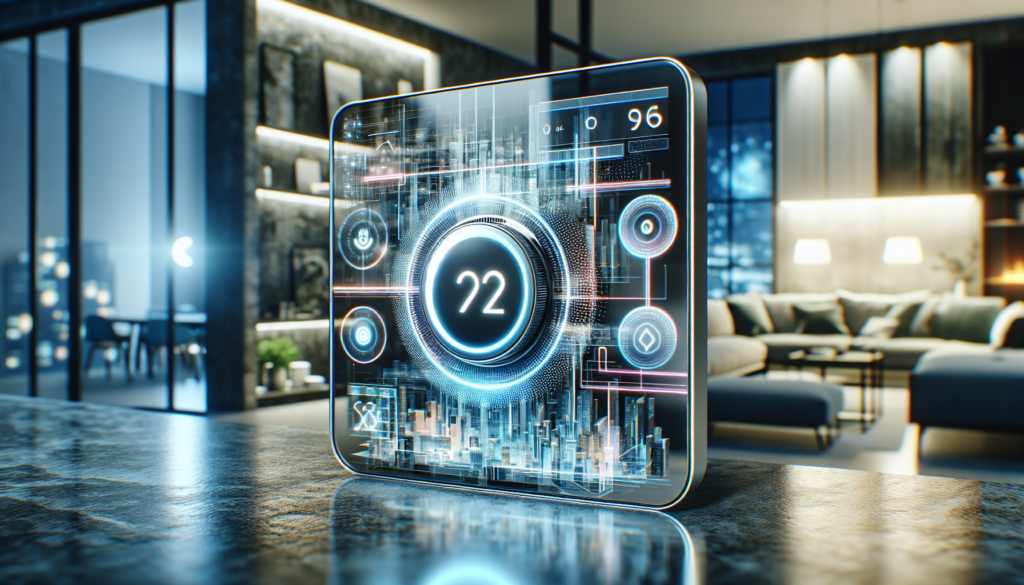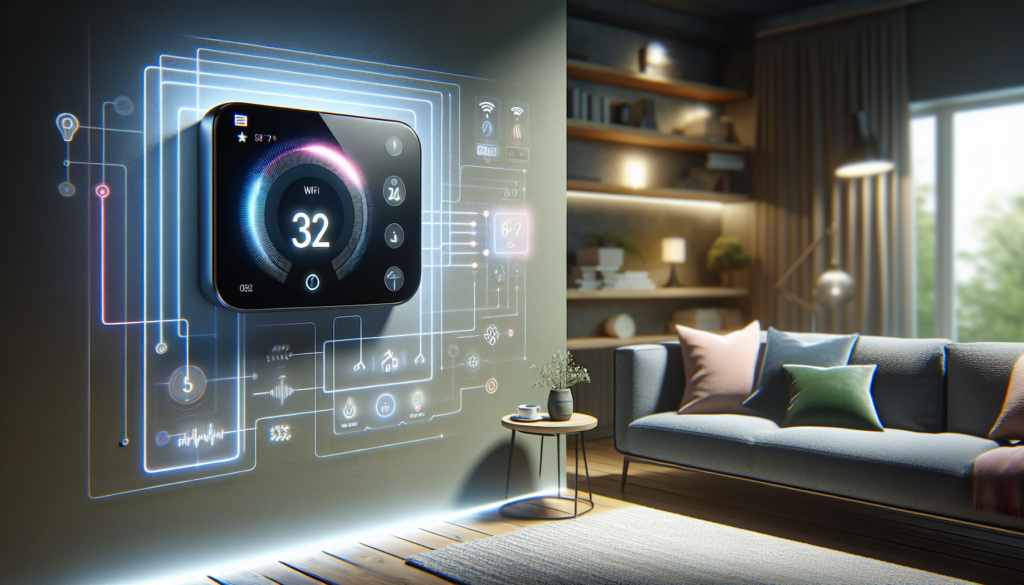Imagine being able to control the temperature of your home with just a few taps on your phone. Picture a thermostat that not only learns your preferences, but also adjusts itself based on your schedule and weather conditions. This is the exciting world of smart thermostat technology, where convenience meets energy efficiency. In this article, we will explore the latest trends and innovations in this rapidly evolving field, from voice-activated controls to integration with smart home systems. Get ready to discover how these cutting-edge advancements are revolutionizing the way we manage our home’s climate.

Voice Control Integration
In recent years, one of the most prominent trends in smart thermostat technology has been the integration of voice control capabilities. By connecting with smart assistants such as Amazon Alexa or Google Assistant, you can now control your thermostat settings using simple voice commands. This integration has significantly increased the convenience and accessibility of smart thermostats, allowing you to adjust temperature settings or change modes without having to physically interact with the device. Whether you’re lounging on the couch or busy in the kitchen, you can simply say, “Hey Google, lower the temperature to 68 degrees,” and your smart thermostat will respond accordingly.
Increased Compatibility with Smart Assistants
To ensure seamless voice control integration, smart thermostat manufacturers have been working hard to enhance compatibility with popular smart assistant platforms. Whether you’re an Alexa enthusiast or a Google Assistant user, you can now find a wide range of smart thermostats that are compatible with your preferred smart assistant. This compatibility allows for a hassle-free integration process, ensuring that you can easily connect your smart thermostat to your home’s existing smart assistant ecosystem.
Improved Voice Recognition Technology
Part of the reason why voice control integration has become so popular is the advancements in voice recognition technology. Smart thermostats equipped with sophisticated microphones and advanced algorithms can accurately interpret your voice commands, even in noisy environments. Whether you have a strong accent or are speaking from across the room, these innovative smart thermostats can intelligently understand your instructions and execute them promptly. With improved voice recognition technology, you no longer have to worry about repeating yourself or struggling to make your smart thermostat understand your commands.
Geofencing
Another significant trend in smart thermostat technology is the integration of geofencing capabilities. Geofencing allows your smart thermostat to detect when you leave or enter a designated area, usually your home, based on the location of your smartphone. This technology enables enhanced home automation features and customizable settings tailored to your lifestyle.
Enhanced Home Automation Features
With the implementation of geofencing, your smart thermostat can automatically adjust temperature settings based on your location. For instance, when you leave your home, the thermostat can enter an energy-saving mode, adjusting the temperature to conserve energy while you’re away. Upon your return, the thermostat can quickly detect your presence and resume regular comfort settings, ensuring a cozy environment as soon as you step through the door. This automation not only saves you time but also helps optimize energy consumption by eliminating the need to manually adjust your thermostat every time you enter or leave your home.
Customizable Geofencing Settings
To provide users with greater control and flexibility, smart thermostats now offer customizable geofencing settings. You can set the radius of your geofence, allowing you to define the exact area within which your thermostat should respond to your presence. This customization empowers you to fine-tune your smart thermostat’s behavior according to your preferences. Whether you prefer a larger geofence for more flexibility or a smaller one for precise temperature adjustments, the choice is yours. With customizable geofencing settings, you can create a smart home experience that aligns perfectly with your lifestyle.

Learning Algorithms
Integrating advanced learning algorithms into smart thermostats has become a game-changer in the world of home automation. These algorithms allow smart thermostats to analyze various data points and dynamically adjust temperature settings to optimize comfort and energy efficiency.
Adaptive Temperature Control
Smart thermostats equipped with learning algorithms can adapt to your temperature preferences over time. By monitoring and analyzing your temperature adjustments, these thermostats can learn your ideal comfort levels at different times of the day, and even under varying weather conditions. As a result, the smart thermostat can automatically adjust temperature settings to meet your preferences, ensuring you feel comfortable at all times without the need for manual intervention.
Energy-saving Recommendations
Learning algorithms not only improve comfort levels but also help you save energy. By studying your energy consumption patterns and analyzing data from various sensors, smart thermostats can provide energy-saving recommendations tailored to your lifestyle. These recommendations may include adjusting temperature settings during certain periods of the day, utilizing energy-efficient modes, or even suggesting optimal temperature ranges for different seasons. By adopting these energy-saving recommendations, you can reduce your environmental footprint and lower your energy bills without compromising on comfort.
Intuitive User Interface
To make smart thermostats more user-friendly and accessible to a wide range of users, manufacturers have been focusing on developing intuitive user interfaces that simplify the setup and configuration process.
Touchscreen Displays
One of the most noticeable advancements in user interfaces is the integration of touchscreen displays in smart thermostats. These displays provide a visual and interactive interface, allowing you to easily navigate through menus, adjust settings, and access various features. With vibrant colors, sharp graphics, and intuitive icons, touchscreen displays make it effortless to interact with your smart thermostat. Whether you’re setting a schedule, checking energy usage, or exploring advanced settings, you can do so with just a few taps on the responsive touchscreen.
Simplified Setup and Configuration
Setting up a smart thermostat can sometimes be intimidating, especially for first-time users. To eliminate this barrier, manufacturers have been focusing on simplifying the setup and configuration process. With intuitive on-screen instructions and step-by-step guidance, you can quickly connect your smart thermostat to your home’s Wi-Fi network and configure personalized settings. Additionally, some smart thermostats even offer guided tutorials or video demonstrations to help you get started. This simplified setup process ensures that anyone, regardless of technical expertise, can easily install and configure their smart thermostat and begin enjoying the benefits of home automation.

Remote Access and Monitoring
Smart thermostats have revolutionized the way we interact with our heating and cooling systems, enabling remote access and monitoring capabilities that provide unparalleled convenience and control.
Mobile App Control
Through dedicated mobile apps, smart thermostat users can now control their devices from anywhere with an internet connection. Whether you’re lying in bed, commuting home from work, or enjoying a vacation abroad, you can effortlessly adjust temperature settings, set schedules, and access advanced features right from your smartphone. With just a few taps on your mobile app, you can ensure that your home is always at the perfect temperature when you arrive or conserve energy while you’re away. Mobile app control offers a level of flexibility and convenience that was previously unimaginable, putting the power of home automation directly in the palm of your hand.
Real-time Energy Usage Tracking
Understanding and monitoring your energy usage is crucial for efficient home management. With smart thermostats, you can now track your real-time energy usage directly from your mobile app or web portal. By providing detailed insights into your energy consumption patterns, these thermostats help you identify areas where you can reduce waste and optimize energy usage. Whether it’s through intuitive graphs or monthly reports, you can stay informed about your energy usage and make informed decisions to minimize your carbon footprint. Real-time energy usage tracking empowers you to take control of your energy consumption and contribute to a more sustainable future.
Integration with Other Smart Home Devices
Smart thermostats are increasingly being designed to seamlessly integrate with other smart home devices, enhancing the overall level of automation and convenience in your home.
Seamless Integration with Smart Lighting Systems
By integrating with smart lighting systems, smart thermostats can enhance the synergy between lighting and temperature control. For example, when you leave your home, your smart thermostat can signal the smart lighting system to turn off unnecessary lights, conserving energy while you’re away. Similarly, when you return, the thermostat can communicate with the lighting system to ensure a welcoming and well-illuminated environment. This seamless integration not only eliminates the need for individual control but also creates a harmonious and efficient smart home ecosystem.
Compatibility with Smart Locks and Security Systems
Incorporating smart locks and security systems into your smart thermostat’s ecosystem provides an added layer of convenience and security. For instance, when you leave your home and arm your security system, your smart thermostat can automatically adjust the temperature to energy-saving settings. Similarly, when you return and disarm the security system, the thermostat can restore your preferred comfort levels. This integration ensures that your home is always comfortable when occupied while optimizing energy consumption when it’s not. Furthermore, it offers peace of mind by providing a holistic view of your home’s security and automation systems in one centralized interface.

Energy-saving Features
Energy efficiency has become a significant focus in smart thermostat technology, leading to the development of various features aimed at reducing energy consumption and minimizing environmental impact.
Automated Scheduling and Temperature Adjustments
One of the most straightforward yet effective energy-saving features in smart thermostats is automated scheduling. By setting personalized schedules based on your daily routines, you can ensure that your heating and cooling systems operate efficiently. For example, you can program your thermostat to lower the temperature during the night or when you’re away at work. Through these automated temperature adjustments, you can avoid wasting energy on maintaining unnecessary comfort levels, leading to substantial energy savings over time.
Thermal Imaging for Efficient Heating and Cooling
Advancements in thermal imaging technology have allowed some smart thermostats to optimize heating and cooling based on specific room conditions. By utilizing built-in sensors or external devices, these thermostats can detect temperature variations across different areas of your home. This data is then used to adjust HVAC settings, ensuring that each room receives the desired level of comfort without overcompensating or overcooling. By fine-tuning heating and cooling based on real-time thermal imaging, smart thermostats maximize energy efficiency and minimize energy waste.
Enhanced Sensors and Connectivity
To improve performance and accuracy, smart thermostats now incorporate enhanced sensors and connectivity options that expand their capabilities and efficiency.
Improved Occupancy and Motion Detection
Smart thermostats equipped with advanced occupancy and motion detection sensors can accurately track the presence of individuals within the home. These sensors reduce the reliance on manual adjustments and provide a more accurate understanding of occupancy patterns. By detecting when you’re in a particular room or when the house is unoccupied, the thermostat can intelligently make necessary temperature adjustments to ensure comfort and conserve energy. Improved occupancy and motion detection sensors contribute to a more efficient and personalized home automation experience.
Wi-Fi and Bluetooth Connectivity
Seamless connectivity is essential in ensuring that your smart thermostat remains up to date and capable of delivering the latest features and functionalities. With integrated Wi-Fi and Bluetooth capabilities, smart thermostats can easily connect and communicate with your home’s internet network and other compatible devices. This connectivity enables automatic software updates, ensuring that your smart thermostat always operates with the latest firmware and security enhancements. Additionally, Wi-Fi and Bluetooth connectivity allow for convenient remote control and access through mobile apps or voice assistants, offering a truly connected and intelligent smart home experience.

Smart Energy Management
Smart energy management is a significant step towards a more sustainable and efficient future, and smart thermostats play a crucial role in this endeavor.
Demand Control Optimization
By integrating with demand control optimization systems, smart thermostats can contribute to reducing the load on the electrical grid during peak demand periods. These systems analyze electricity consumption patterns and communicate with smart thermostats to temporarily adjust temperature settings or enable energy-saving modes to alleviate strain on the grid. By participating in demand response programs, homeowners can actively contribute to a more stable and sustainable energy infrastructure. Smart thermostats act as an essential interface between homeowners and utility companies, enabling effective demand control optimization.
Smart Grid Integration
As part of a broader vision for smarter and more intelligent energy management, smart thermostats are integrating with smart grid technology. With smart grid integration, thermostats can receive signals from the utility company, indicating periods of high or low electricity demand. Based on these signals, the thermostats can make tailored adjustments to temperature settings or energy usage, ensuring that homeowners benefit from incentives or reduced rates. This integration optimizes energy usage, minimizes strain on the electrical grid, and promotes a more resilient and efficient energy system.
Wireless Installation and Upgrades
To cater to a wide range of homes and simplify the adoption of smart thermostat technology, manufacturers have focused on developing wireless installation options and providing software updates for feature expansion.
Easy Retrofitting in Existing Homes
For homeowners who want to upgrade their heating and cooling systems without extensive renovations, wireless installation options are a game-changer. These wireless thermostats do not require complex wiring or modifications to your existing infrastructure, making them ideal for retrofitting in older homes. Simply replace your existing thermostat with a wireless smart thermostat, follow the setup instructions, and you’re ready to experience the benefits of home automation without the hassle of rewiring.
Software Updates for Feature Expansion
An advantage of smart thermostats is their ability to receive software updates, which can bring new features and functionalities to your device even after purchase. Manufacturers frequently release updates to improve performance, enhance security measures, and introduce additional capabilities to the thermostat’s ecosystem. These updates ensure that your investment in a smart thermostat continues to provide long-term value and keeps up with the evolving landscape of home automation. By staying connected to the manufacturer’s software updates, you can benefit from technological advancements without needing to purchase a new device.
As smart thermostat technology continues to evolve, we can expect even more innovative features that prioritize convenience, energy efficiency, and seamless integration with other smart home devices. From voice control integration to geofencing capabilities, learning algorithms to enhanced sensors, the latest trends and innovations in smart thermostat technology are transforming the way we interact with our homes. With these advancements, you can enjoy a more comfortable, efficient, and intelligent living environment while actively contributing to a more sustainable future.










